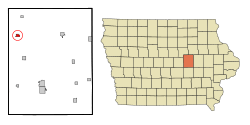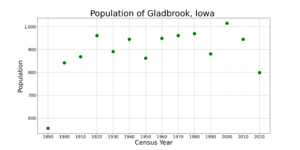Gladbrook, Iowa facts for kids
Quick facts for kids
Gladbrook, Iowa
|
|
|---|---|

Location of Gladbrook, Iowa
|
|
| Country | |
| State | |
| County | Tama |
| Area | |
| • Total | 0.70 sq mi (1.81 km2) |
| • Land | 0.70 sq mi (1.81 km2) |
| • Water | 0.00 sq mi (0.00 km2) |
| Elevation | 974 ft (297 m) |
| Population
(2020)
|
|
| • Total | 799 |
| • Density | 1,146.34/sq mi (442.48/km2) |
| Time zone | UTC-6 (Central (CST)) |
| • Summer (DST) | UTC-5 (CDT) |
| ZIP code |
50635
|
| Area code(s) | 641 |
| FIPS code | 19-31035 |
| GNIS feature ID | 0456914 |
Gladbrook is a small city located in Tama County, Iowa, in the United States. In 2023, about 767 people lived there. It's a quiet place with a friendly community.
Contents
History of Gladbrook
Gladbrook got its name from a railroad official. A post office opened here in 1880, helping the community grow.
Train Accident in 1910
On March 21, 1910, a sad event happened near Gladbrook. A train derailed between Gladbrook and Green Mountain. This accident, known as the Green Mountain train wreck, caused the deaths of more than fifty people who were riding on the Chicago, Rock Island and Pacific train line.
Geography of Gladbrook
Gladbrook is located at 42°11′6″N 92°42′53″W / 42.18500°N 92.71472°W. This tells us its exact spot on a map.
The city covers a total area of about 0.70 square miles (1.81 square kilometers). All of this area is land, meaning there are no large lakes or rivers within the city limits.
People of Gladbrook (Demographics)
| Historical populations | ||
|---|---|---|
| Year | Pop. | ±% |
| 1890 | 556 | — |
| 1900 | 842 | +51.4% |
| 1910 | 869 | +3.2% |
| 1920 | 961 | +10.6% |
| 1930 | 891 | −7.3% |
| 1940 | 945 | +6.1% |
| 1950 | 862 | −8.8% |
| 1960 | 949 | +10.1% |
| 1970 | 961 | +1.3% |
| 1980 | 970 | +0.9% |
| 1990 | 881 | −9.2% |
| 2000 | 1,015 | +15.2% |
| 2010 | 945 | −6.9% |
| 2020 | 799 | −15.4% |
| Source: and Iowa Data Center Source: |
||
The word "demographics" means studying the population of a place. This includes how many people live there, their ages, and other facts.
Gladbrook's Population in 2020
According to the census in 2020, there were 799 people living in Gladbrook. These people lived in 372 households, and 217 of these were families.
The population density was about 1,146 people per square mile (442.5 people per square kilometer). This means how many people live in a certain amount of space.
Most people in Gladbrook (about 94.6%) were White. There were also smaller numbers of Black or African American, Native American, and Asian residents. About 2.0% of the population identified as Hispanic or Latino.
The average age in Gladbrook was 44.9 years old.
- About 22.7% of residents were under 20 years old.
- About 25.5% were 65 years old or older.
- The city had a nearly even split of genders, with 49.2% male and 50.8% female residents.
Arts and Culture in Gladbrook
Gladbrook has some fun events and unique places to visit.
Annual Corn Carnival
One of the biggest events is the Gladbrook Corn Carnival. This celebration happens every year, usually on the last weekend of June. It has been a tradition since 1922 and brings thousands of visitors to the city. You can enjoy many different activities from Thursday to Sunday.
Matchstick Marvels Museum
Gladbrook is home to the Matchstick Marvels Museum. This museum displays amazing creations made entirely out of matchsticks by an artist named Patrick Acton. Some of his incredible matchstick models have even been shown in Ripley's Believe It or Not! museums around the world.
Parks and Recreation
Gladbrook offers several ways for people to have fun and stay active.
- Movie Theater: You can catch the latest films at the local movie theater.
- Fitness Center: There's a 24-hour fitness center for those who like to work out.
- Bike and Walking Trail: A trail is available for biking and walking, perfect for outdoor exercise.
Union Grove Park
Just three miles south of Gladbrook, you'll find Union Grove State Park. This park is a great place for outdoor adventures. It features:
- A public beach where you can relax.
- Several picnic areas for outdoor meals.
- Places for public fishing.
- Campgrounds if you want to stay overnight.
- Short hiking trails to explore nature.
Education
Students in Gladbrook are part of the Gladbrook–Reinbeck Community School District. While there used to be an elementary and middle school in Gladbrook, it closed in 2015. Now, students attend school in the nearby town of Reinbeck.
Notable Person from Gladbrook
- Clifford Berry: He was an important scientist who helped create the first digital electronic computer in 1939. This computer, called the Atanasoff–Berry Computer, was built at Iowa State.
See also
 In Spanish: Gladbrook para niños
In Spanish: Gladbrook para niños


